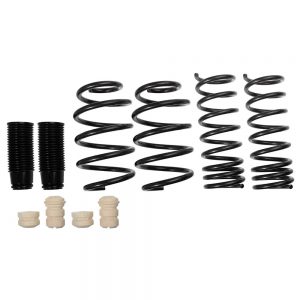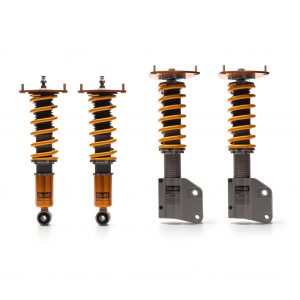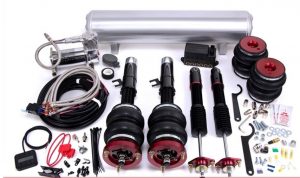Lowering Springs, Coilovers, and Air Suspension: An Overview
Lowering Springs, Coilovers, and Air Suspension: An Overview
A vehicle’s suspension is one of the most critical but often overlooked systems. It consists of several components that connect the chassis of the vehicle to the road surface. There are different ways to make up a suspension system like coilovers or leaf springs but all work to achieve the same goals. These goals are to maintain an ideal balance of comfort, contact, and control. Comfort smooths out bumps for a comfortable ride. Control minimizes weight transfer for safe acceleration, braking, and cornering. Contact refers to the tires contacting the road surface to maintain the most traction.
Let’s first look at some common components of a suspension system to get an understanding of how they work together.
Maintaining an ideal balance of comfort, contact, and control is easier said than done as these goals are typical indirectly proportional. Increasing control will mean sacrificing comfort and vice versa. A factory suspension system will typically have a focus on comfort. A more performance oriented model will typically be less comfortable but still leave a lot of room for improvement when it comes to contact and control. Increasing the latter two categories is what most enthusiasts are after.
There are many ways to go about gaining contact and control. One of the easiest ways is to lower the car. By using a shorter spring, the center of gravity along with everything else becomes lower. This improves handling, reduces body roll, and looks cool. Among the most common ways to achieve better contact and control by lowering the car come by way of lowering springs, coilovers, or air suspension. The following is an overview of each that examines some of the pros and cons of each setup.
Lowering Springs

A set of lowering springs is the usual suspect when it comes to aftermarket suspension modifications. It is the least expensive, typically a direct factory replacement, and will usually work in conjunction with the rest of your stock components. However, there are a few things to consider.
You’ll definitely want to know how much of a drop the springs will provide. We all want our car to look good but lowering it too much can cause several problems. Too much of a drop will cause poor alignment, bad handling characteristics, scraping on the ground or rubbing tires, premature damper failure, and more. Most springs will lower the car about an inch to an inch and a half. This amount works great for most vehicles and will work with the stock wheel and tire size along with the stock dampers.
Another thing to consider is the spring rate. The stiffer the spring, the less body roll and more control. However, this will come at the expense of comfort. This would be fine for a smooth race track but if you’re daily driving, you’ll soon learn of every imperfection in the road.
A progressive spring rate offers the best of both worlds. Check out the “Linear Vs. Progressive Springs: Which is Better for Your Car?” for more details on progressive springs.
For lowering springs, COBB recommends the Eibach PRO-KIT. The Eibach PRO-KIT is the perfect answer for most frequently-driven street cars. It’s their legendary sport spring system that dramatically improves both a vehicle’s performance and appearance. PRO-KIT precisely lowers your car’s center of gravity, reducing squat during acceleration, body roll in corners and excessive nose-dive under braking. When combined with Plus-1 or Plus-2 wheels and tires, the Eibach PRO-KIT is the finishing touch to a winning recipe for performance. PRO-KIT also reduces excessive fender-well clearance, making your car look just as hot as it performs.
Coilovers

Coilver is a term short for coil over strut. This is similar to a lowering spring in the sense that it can lower your car but it has several advantages with adjustability.
The greatest advantage a coilover offers is ride height adjustment. This works by replacing the factory springs with spring over a strut that rides on a locking collar on a sleeve. Some units allow for adjustment between preload on the spring independent of the ride height. Beyond that, some units will have adjustable dampening allowing for a true racing experience without losing comfort when commuting to work.
For Coilovers, COBB recommends the Öhlins Road & Track Coil Over system. It offers a unique Dual Flow Valve (DFV) technology allows you to quickly change the stiffness of the shock absorber. When arriving to the racetrack, just turn the golden knob clockwise on the damper to set it in race mode this action changes all four areas in the damper; low and high speed compression and rebound damping.
The main disadvantage is that a coilover system can be very expensive.
With Öhlins Road & Track coil overs you will experience a car with blistering response times, improved bump absorption and a massive amount of grip to increase the safety when driving your car on the limit. The car will be easier to balance on the edge of what the tires can handle before losing grip. You will be much quicker on track. The DFV suspension prevents you from losing the racing line when hitting bumps or curbs. The DFV components within react quickly and keeps you in control of the car and in contact with the track. When driving to and from the track, just set the dampers in road mode for a more relaxed and comfortable drive. The setting offers more grip and quicker response time than ever before.
Air Suspension

Air suspension is infinitely adjustable and looks awesome but is typically the most expensive and complicated.
This suspension replaces the traditional strut and spring combo with an air bag. This bag uses compressed air to inflate or deflate to offer changes in ride height. The air pressure comes from an on-board tank connected to each bag via air lines. Valves between the tank and each bag can control the amount of pressure. This adjustability is even better than what a coilover offers since it can be done in real time.
Aside from the initial cost, the complexity of air ride can also be a downside. Maintaining an air suspension system is often more complicated and costly than traditional setups. They can also be prone to leaks that can leave you stranded.
There are several kits out there. Many vehicles will require some sort of custom modification or fabrication to work. If you have a popular tuning car, there may be a bolt-on kit specific to your vehicle. If that is the case, that would be the recommendation.
Things to Consider
Whether you go with lowering springs, coilovers, or air suspension, your car can have a properly setup suspension. This can compliment your other mods and make your car way more fun to drive. One thing to note: anytime you make suspension adjustments, you’re going to want to make sure to realign your car. When you modify suspension, the alignment becomes affected. Getting a proper alignment l prevents uneven tire wear and poor handling.
Whether you like imports, classics or american muscle cars, most like their cars to look and feel aggressive. Most of the time, lowering the car is part of that process and is usually a good thing. But, when it comes to changing ride height, there can be too much of a good thing.
Now we’re not talking about race cars or show cars that have a suspension setup for one purpose and usually invest far more time and money than most people could match to make it work properly. What we are talking about is your daily driver or your weekend toy that you’re trying to get the best performance out of. Lowering it too much can create a plethora of problems.
One that is usually obvious is scraping around the ground. It’s dangerous because the car can’t handle or brake properly. That’s because you can’t make a car that low without breaking some rules like excessive camber, tires rubbing in the wheel well, incorrect alignment and tire size and so on.
For those that care most about performance, adjustability and set up is the issue. You could go out and dump your checking account on the nicest set of suspension parts that allow you to adjust ride height, damping, camber, toe in and out, and then crank everything up to eleven. But first understand that parts are designed with working ranges. Once you exceed those ranges, you can actually make the car perform worse than if you just would’ve just left them alone.
Brakes are another area to upgrade once you start making more power. See Cross vs Slotted Rotors and How to Bleed Brakes By Yourself for more details.

Do you have front lowering springs for 2004 Sienna if i want to lower to 1-1.5 inches?
Hi Tony,
We do not. Sorry for the bad news.
Kyle@COBB